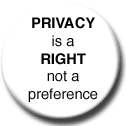Terrorists, Steganography, and False Alarms
Thanks to Bruce Schneier for pointing this out.
Via The Guardian UK.
The first sign that something was amiss came a few days before Christmas Eve 2003. The US department of homeland security raised the national terror alert level to "high risk". The move triggered a ripple of concern throughout the airline industry and nearly 30 flights were grounded, including long hauls between Paris and Los Angeles and subsequently London and Washington.
But in recent weeks, US officials have made a startling admission: the key intelligence that prompted the security alert was seriously flawed. CIA analysts believed they had detected hidden terrorist messages in al-Jazeera television broadcasts that identified flights and buildings as targets. In fact, what they had seen were the equivalent of faces in clouds - random patterns all too easily over-interpreted.
At the heart of the fiasco lies a technique called steganography, the art, and now hardcore science, of hiding messages. There's nothing new about steganography, in principle at least. Herodotus tells the tale of Histiaeus who, in the sixth century BC, shaved the head of his most trusted slave, tattooed a message on his scalp and let his hair regrow. The slave then travelled unchallenged to Aristagoras ,who was instructed to shave the slave's head, revealing the message urging him to revolt against the Persians. In common with modern steganography, it ensured that outsiders didn't know a secret message existed.








0 Comments:
Post a Comment
<< Home